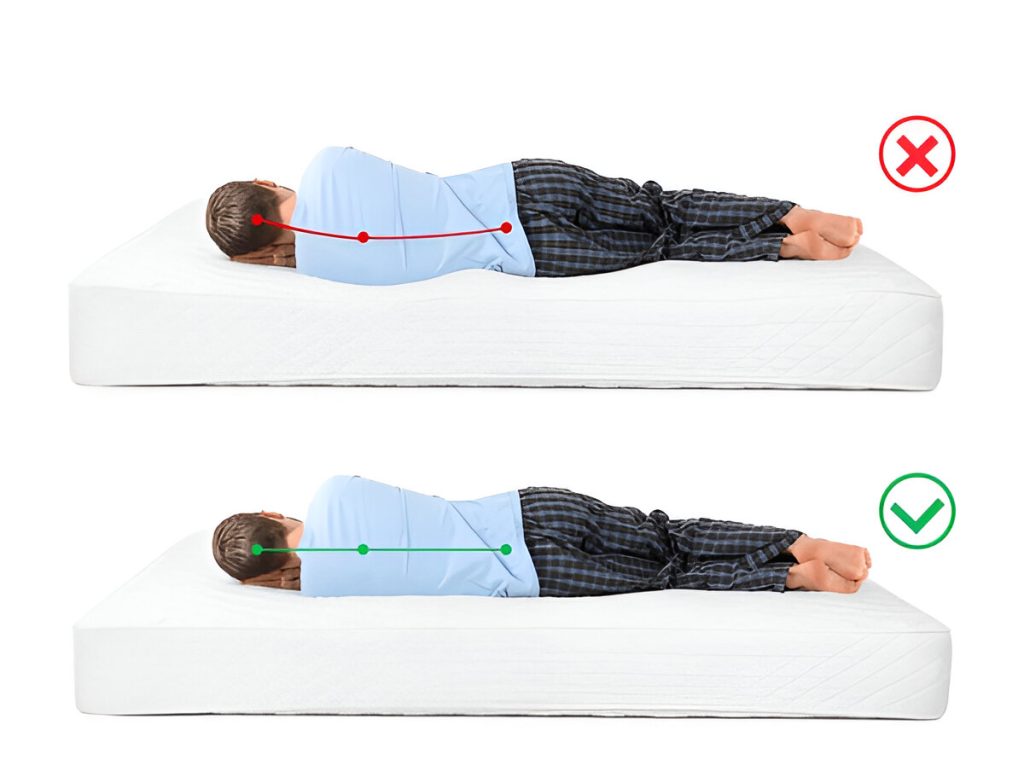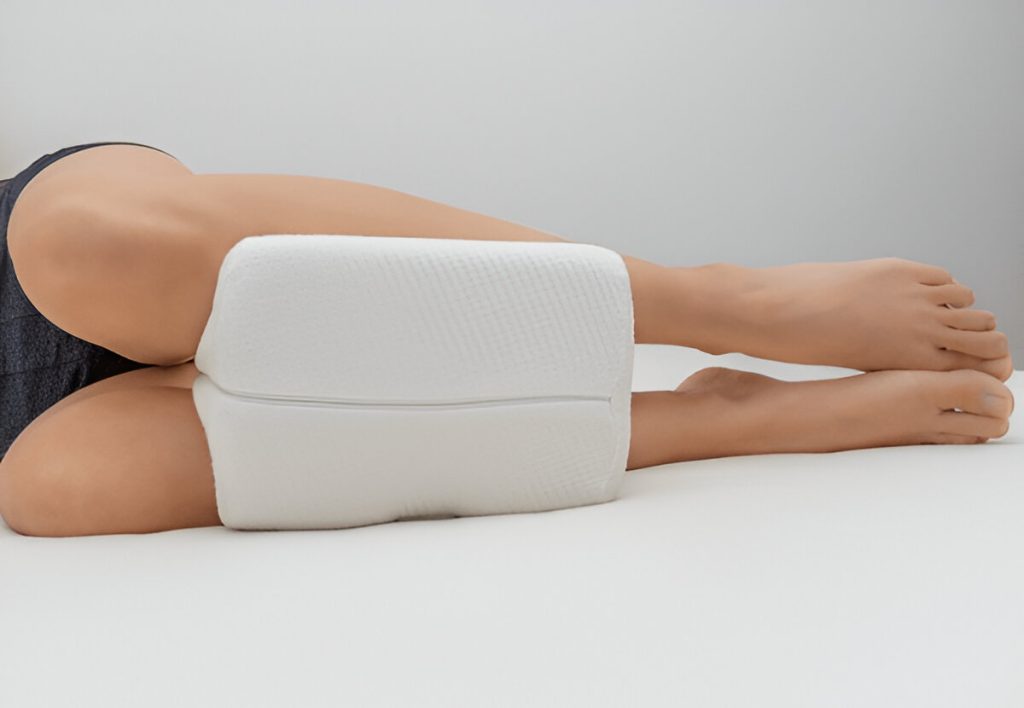Best Sleeping Position for SI Joint Pain
Finding the best sleeping position for SI joint pain can be a game-changer for patients struggling with nighttime discomfort. When SI joint pain worsens at night, it disrupts rest and leads to morning stiffness. At King’s Spine Centre, our spine experts explain exactly how to sleep with SI joint pain for maximum comfort and long-term relief.
In this guide, you will learn:
Why SI joint pain flares at night
The two best sleeping positions for sacroiliac joint pain relief
Pillows, mattress, and setup tips for comfort
Morning stiffness hacks and pregnancy-specific advice
Expert insights and FAQs for lasting results
If you’ve been searching for SI joint sleeping position tips or ways to get better sleep without pain, this step-by-step guide will help you find the right position and maintain it every night.

Why SI joint pain flares at night
Nighttime often magnifies sacroiliac discomfort because:
Lying in one position for hours can stress the SI joint
Twisting or dropping one side of the pelvis strains ligaments
Lack of movement causes stiffness and muscle guarding
By using a correct sleeping position for SI joint pain, you can neutralize the pelvis, reduce pressure, and wake up with less stiffness.
Goals for pain-reducing sleep posture
Keep the pelvis neutral, avoiding twisting or dropping on one side to optimize a chosen si joint sleeping position.
Maintain a gentle lumbar curve, especially when supine, using pillows to avoid overextension or flattening consistent with best sleeping position for si joint pain.
Support the legs so the femurs and pelvis stay aligned, which is essential to effective sleeping position sacroiliac joint pain relief.

The two primary sleeping setups that work best
Research and clinical experience highlight two primary sleeping positions that work best for SI joint pain relief:
1. Back Sleeping with Pillows Under the Knees
This is the most recommended SI joint sleeping position because it:
Distributes pressure evenly across the pelvis
Reduces shearing at the SI joints
Maintains a neutral lumbar spine
Setup:
Lie on your back with a low-to-medium head pillow
Place a supportive pillow under the knees for slight bend
If needed, add a thin lumbar roll to support the natural curve
Quick Relief Tip:
Book a consultation at King’s Spine Centre to learn correct posture habits that protect your SI joints day and night.
2. Side Sleeping on the Non-Painful Side
Side sleeping can work well if the painful SI joint faces up to reduce compression.
Setup:
Lie on the non-painful side to unload the joint
Place a medium pillow between knees and ankles
Keep ankles, knees, and hips stacked to prevent pelvic rotation
Fill waist gaps with a small pillow to maintain spinal alignment
Positions to avoid or modify
Stomach sleeping: Can overextend the lower back and strain SI joints. If unavoidable, use a pillow under the pelvis.
Half-twist sleeping: One leg drawn up or forward creates pelvic torsion and should be avoided.
Addressing common symptom scenarios
If waking frequently with deep buttock or low-back ache, check if the knees are drifting together or the top leg is rotating forward; this breaks sleeping position sacroiliac joint pain relief alignment. Reset the knee pillow and re-stack hips to return to a true si joint sleeping position and restore the best sleeping position for si joint pain principles.
If back sleeping creates low-back tightness, use a thicker pillow beneath the knees or add a thin lumbar roll; this often restores comfort and preserves a therapeutic si joint sleeping position consistent with best sleeping position for si joint pain.
Micro-adjustments that make a big difference
Pillow height matters: side sleepers need a head pillow that fills the shoulder-to-head gap so the neck stays level, reinforcing sleeping position sacroiliac joint pain relief through full-spine neutrality that complements any si joint sleeping position.
Knee-pillow thickness: when too thin, the top leg rolls forward; when too thick, hips side-bend. Target hip-width spacing to maintain the best sleeping position for si joint pain and the intended si joint sleeping position.
Mattress firmness: too soft collapses pelvic support; too hard may create pressure points and guarding. Medium to medium-firm often supports sleeping position sacroiliac joint pain relief and the best sleeping position for si joint pain across body types.

Night routine checklist (5-minute setup)
Choose position: back or non-painful side, whichever provides more immediate sleeping position sacroiliac joint pain relief and matches the best sleeping position for si joint pain.
Place pillows: under knees (back sleeping) or between knees and ankles (side). This locks in a stable si joint sleeping position.
Add supports: small waist pillow (side) or thin lumbar roll (back) to fine-tune the si joint sleeping position and reinforce sleeping position sacroiliac joint pain relief.
Test breath and scan: if breath is free and hips feel level, posture is likely correct under the best sleeping position for si joint pain model.
Morning stiffness hacks for si joint pain
-
Before getting out of bed, roll onto your side with knees together.
-
Push up using both arms instead of twisting.
-
If stiffness persists, re-create your SI joint sleeping position for a few deep breaths before rising.
Pregnancy Tips for Sleeping with SI Joint Pain
Pregnancy often increases ligament laxity, making SI joint pain worse at night. To reduce discomfort:
Use a full-length body pillow
Sleep on your side with the pillow between knees and ankles
Hug the pillow to prevent trunk rotation and maintain alignment
Pillow and bedding guidance
Knee pillow: Choose a medium density that maintains hip-width spacing to sustain sleeping position sacroiliac joint pain relief and a dependable si joint sleeping position.
Under-knee pillow (back sleeping): A wedge or thick bolster keeps gentle knee flexion and reduces hip-flexor tension, improving best sleeping position for si joint pain consistency.
Mattress: Medium or medium-firm usually balances pressure relief with pelvic stability—both are required for a reproducible si joint sleeping position and lasting sleeping position sacroiliac joint pain relief.
Expert advice from king’s spine centre
At King’s Spine Centre, clinicians emphasize that sleep setup is a treatment pillar on par with daytime posture. Patients reporting nighttime flare-ups often improve rapidly after adopting back sleeping with knee support or side sleeping on the non-painful side with strict leg stacking. Consistency is key: repeat the chosen SI joint sleeping position nightly and re-check pillow thickness every few weeks to preserve sleeping position sacroiliac joint pain relief under the best sleeping position for SI joint pain blueprint.
If you are struggling with sacroiliac joint pain and want expert guidance on the best sleeping positions, personalized pain management, and long-term relief strategies, Schedule an appointment today at King’s Spine Centre to receive a personalized sleep and posture plan for SI joint pain relief. Start your journey to pain-free sleep now!
Strategic reminders for consistent relief
Rehearse your setup during the day for 60 seconds to reinforce muscle memory—this helps transition into sleeping position sacroiliac joint pain relief at night and maintain a stable si joint sleeping position.
Replace pillows that compress too much over time; sagging pillows can undo the best sleeping position for si joint pain advantages and destabilize the si joint sleeping position.
Ready to wake up pain-free? Book your consultation at King’s Spine Centre and get expert guidance on sleeping positions, posture habits, and long-term SI joint pain relief strategies.
Frequently Asked Questions (FAQs)
Keep the pelvis neutral and avoid twisting. Whether on the back or side, this preserves sleeping position sacroiliac joint pain relief, sustains a true si joint sleeping position, and aligns with the best sleeping position for si joint pain framework.
Yes—if back sleeping, a small roll maintains the natural curve and supports sleeping position sacroiliac joint pain relief, complementing the si joint sleeping position and the best sleeping position for si joint pain.
Many notice better sleep within days once supports are used consistently; morning stiffness reduction follows as the si joint sleeping position becomes habitual, reinforcing durable sleeping position sacroiliac joint pain relief and cementing the best sleeping position for si joint pain.
If possible, yes. If not, modify with a pelvic pillow to approximate sleeping position sacroiliac joint pain relief and reduce torsion—this narrows the gap toward the si joint sleeping position and edges closer to the best sleeping position for si joint pain standard.
Yes. A mattress that is too soft may let the pelvis sink, misaligning the spine/SI joints. Too firm may create pressure points. Medium-firmer mattresses often provide better pelvic stability.
People ask: how thick, how firm, what shape. For example: a head pillow that fills the shoulder gap (for side-sleepers), a lumbar roll if there’s a gap under low back (for back-sleepers), and knee pillows of medium density to keep hips aligned.
Usually it’s not recommended because it hyper-extends the lumbar spine and increases SI joint stress. But if someone can’t avoid it, modifications like placing a pillow under the pelvis/lower abdomen to reduce lumbar arch can help.
Many people notice some relief within one to a few nights; more significant and lasting reductions in morning stiffness or pain tend to show up over a couple of weeks with consistent positioning. (Depends on severity and other factors.)
Use pillows or bolsters strategically: behind the back to prevent rotating, between knees and ankles, or against the mattress to block rolling. Some people also use body pillows or higher barriers.
Use full-body or maternity pillows, place pillows between knees and under abdomen, avoid lying flat on the back in late pregnancy, maybe use a pregnancy or SI-support belt.
Yes. What you do during the day sitting posture, standing posture, carrying load, repeated twisting influences how tight or inflamed the joint is by bedtime. So combining sleep position with daytime ergonomics/exercises helps.
The best sleeping position may need additional modifications: more support, more frequent micro-adjustments, perhaps even custom pillows or mattress toppers. Consulting a clinician is especially important in such cases. (You might want to include a note about “if you have comorbid spine/hip conditions, seek individualized advice.”)
If pain persists beyond 1-2 weeks of trying proper positioning, gets worse, is associated with numbness, weakness, or radiating pain, or if sleep disturbance becomes severe, medical evaluation is warranted.
Medical Disclaimer
This blog is for informational purposes only and is not a substitute for professional medical advice, diagnosis, or treatment. Always consult your physician or a qualified healthcare provider regarding any medical questions or concerns.
Review Note
This content has been medically reviewed by the spine care team at King’s Spine Centre, Dubai, to ensure accuracy and relevance. Our team follows evidence-based guidelines and uses advanced diagnostic tools such as MRI and CT scans to evaluate spinal conditions.


